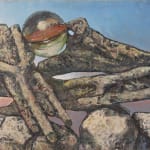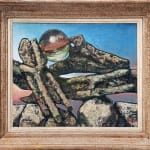

Mayo (Antoine Malliarakis) (1905-1990)
Mayo frequented Parisian avant-garde circles and attended the Surrealists' meetings from 1924, where he met André Breton, Max Ernst, René Magritte and Yves Tanguy. He first exhibited alongside De Chirico, at the Galerie des Quatre Chemins in 1929
This work dates from Mayo's Période Romaine, when in 1966, the artist moved his soon-to-be demolished Paris studio to theVia Magutta in Rome. Following on from this move, Mayo began a new body of work based upon Ovid's Metamorphoses, and explored the communion between the human figure and nature, depicting volumes and depths through a masterful and bold use of colour. His iconography from this period included symbolic elements such as stones, walls, and cascades - all treated in an anthropomorphic manner - and Rosée du Matin is an excellent example of this. The picture brings to mind one of the most seminal Surrealist works: Salvador Dali's (1904-1989) Metamorphosis of Narcissus, now in the collection of the Tate Galleries.
Provenance
Galerie Armand Zerbib, Private collection, Paris

